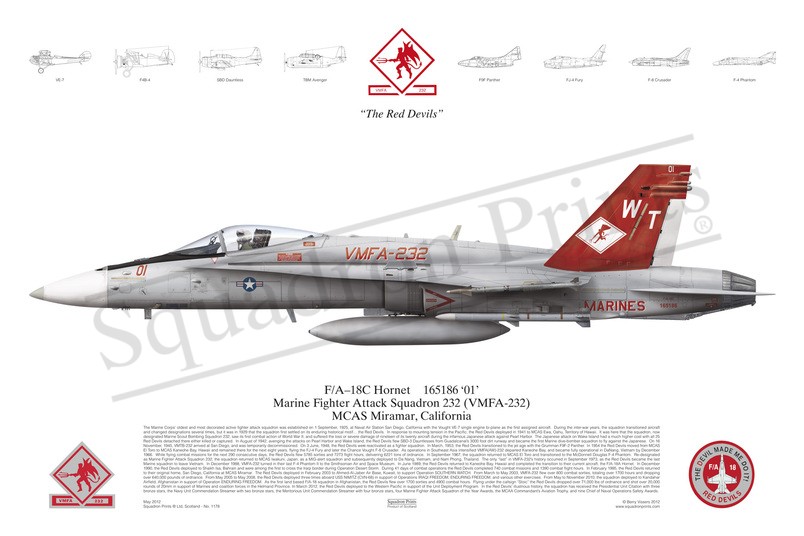#1178 F/A-18C Hornet

Purchased products will not feature the Squadron Prints watermark
Description
Squadron Prints Lithograph No. 1178, F/A-18C Hornet, 165186 \'01\', Marine Fighter Attack Squadron 232 (VMFA-232), MCAS Miramar, California.
The Marine Corps\' oldest and most decorated active fighter attack squadron was established on 1 September, 1925, at Naval Air Station San Diego, California with the Vought VE-7 single engine bi-plane as the first assigned aircraft. During the inter-war years, the squadron transitioned aircraft and changed designations several times, but it was in 1929 that the squadron first settled on its enduring historical motif... the Red Devils. In response to mounting tension in the Pacific, the Red Devils deployed in 1941 to MCAS Ewa, Oahu, Territory of Hawaii. It was here that the squadron, now designated Marine Scout Bombing Squadron 232, saw its first combat action of World War II, and suffered the loss or severe damage of nineteen of its twenty aircraft during the infamous Japanese attack against Pearl Harbor. The Japanese attack on Wake Island had a much higher cost with all 25 Red Devils detached there either killed or captured. In August of 1942, avenging the attacks on Pearl Harbor and Wake Island, the Red Devils flew SBD-3 Dauntlesses from Guadalcanal\'s 3000 foot dirt runway and became the first Marine dive-bomber squadron to fly against the Japanese. On 16 November, 1945, VMTB-232 arrived at San Diego, and was temporarily decommissioned. On 3 June, 1948, the Red Devils were reactivated as a fighter squadron. In March, 1953, the Red Devils transitioned to the jet age with the Grumman F9F-2 Panther. In 1954 the Red Devils moved from MCAS El Toro to MCAS Kaneohe Bay, Hawaii and remained there for the next eight years, flying the FJ-4 Fury and later the Chance Vought F-8 Crusader. As operations in Southeast Asia intensified VMFA(AW)-232 departed Kaneohe Bay, and became fully operational in DaNang, Vietnam by December 1966. While flying combat missions for the next 290 consecutive days, the Red Devils flew 5785 sorties and 7273 flight hours, delivering 6221 tons of ordnance. In September 1967, the squadron returned to MCAS El Toro and transitioned to the McDonnell Douglas F-4 Phantom. Re-designated as Marine Fighter Attack Squadron 232, the squadron returned to MCAS Iwakuni, Japan, as a MIG-alert squadron and subsequently deployed to Da Nang, Vietnam, and Nam Phong, Thailand. The only \"last\" in VMFA-232\'s history occurred in September 1973, as the Red Devils became the last Marine squadron to leave Vietnam. In December 1988, VMFA-232 turned in their last F-4 Phantom II to the Smithsonian Air and Space Museum. In June 1989, the Red Devils returned to Kaneohe Bay, Hawaii and completed the transition to their current aircraft, the F/A-18A Hornet. In December 1990, the Red Devils deployed to Shaikh Isa, Bahrain and were among the first to cross the Iraqi border during Operation Desert Storm. During 41 days of combat operations the Red Devils completed 740 combat missions and 1390 combat flight hours. In February 1995, the Red Devils returned to their original home, San Diego, California at MCAS Miramar. The Red Devils deployed in February 2003 to Ahmed-Al-Jaber Air Base, Kuwait, to support Operation SOUTHERN WATCH. From March to May 2003, VMFA-232 flew over 800 combat sorties, totaling over 1700 hours and dropping over 640,000 pounds of ordnance. From May 2005 to May 2008, the Red Devils deployed three times aboard USS NIMITZ (CVN-68) in support of Operations IRAQI FREEDOM, ENDURING FREEDOM, and various other exercises. From May to November 2010, the squadron deployed to Kandahar Airfield, Afghanistan in support of Operation Enduring Freedom. As the first land based F/A-18 squadron in Afghanistan, the Red Devils flew over 1700 sorties and 4900 combat hours. Flying under the callsign \"Stoic\" the Red Devils dropped over 71,000 lbs of ordnance and shot over 20,000 rounds of 20mm in support of Marines and coalition forces in the Helmand Province. In March 2012, the Red Devils deployed to the Western Pacific in support of the Unit Deployment Program. In the Red Devils\' illustrious history, the squadron has received the Presidential Unit Citation with three bronze stars, the Navy Unit Commendation Streamer with two bronze stars, the Meritorious Unit Commendation Streamer with four bronze stars, four Marine Fighter Attack Squadron of the Year Awards, the MCAA Commandant\'s Aviation Trophy, and nine Chief of Naval Operations Safety Awards.
You may also like
-
Griffon, AW109, Puma and Chinook Print
ZJ954; ZK550; ZH902; ZJ706; GZ100SH Avn StdsRAF Benson; RAF Odiham
